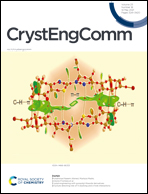The modulation effect of electron-rich solvents on the supramolecular networks and photochromic properties of naphthalene diimide molecules†
Abstract
Four naphthalene diimide-based organic molecules comprising donor–acceptor units, 3-DPNDI (1), [3-DPNDI]·2DMF (2), [3-DPNDI]·2NMP (3) and [3-DPNDI]·4DMSO (4) (3-DPNDI = N,N′-di-(3-pyridyl)-1,4,5,8-naphthalene diimide, DMF = dimethyl formamide, NMP = N-methyl-2-pyrrolidone, DMSO = dimethyl sulfoxide), have been synthesized, which exhibit different supramolecular networks through lone pair–π interactions and discriminative photoinduced electron transfer (ET) accompanying photochromic properties. The combination of different electron-rich solvents with electron-deficient component 3-DPNDI causes the distinct interfacial contacts of electron donors/acceptors, which should be responsible for the different photoresponsive behaviors of 2–4. More importantly, the introduction of DMF and NMP into 3-DPNDI crystal lattices leads to a positive effect on the photoresponsive rate and coloration contrast, while DMSO gives rise to a negative influence on the photochromic properties. This present study illustrates the influence of electron-rich solvents on the resultant supramolecular networks and photochromic behaviors with tunable photoresponsive properties.

- This article is part of the themed collection: Supramolecular & Polymorphism


 Please wait while we load your content...
Please wait while we load your content...